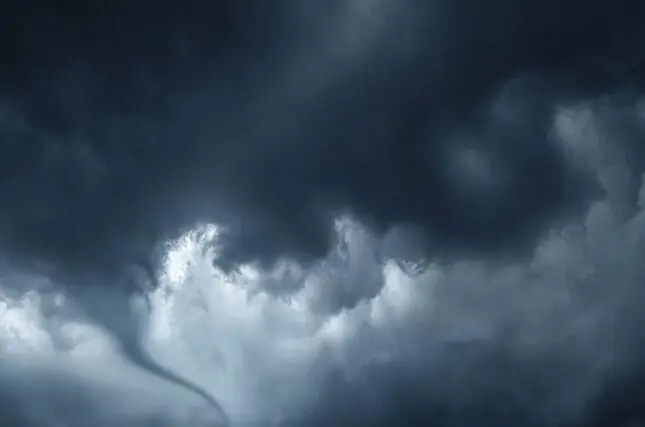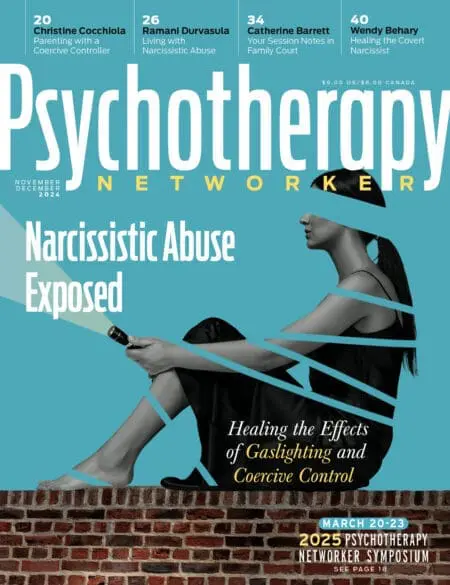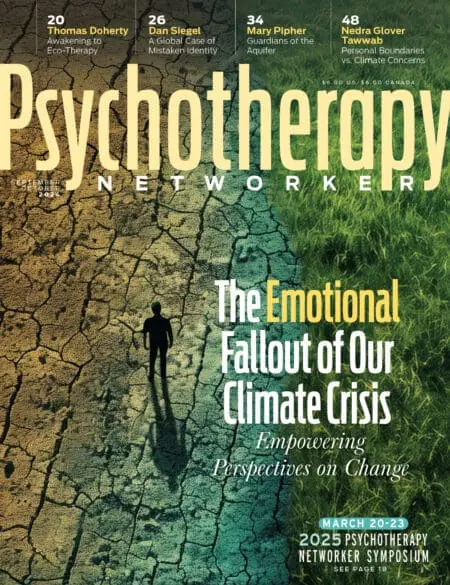When I’d last glanced over my client’s shoulder to check the time, the clock on the wall had read 2:22 p.m., and our initial chit-chat had just begun to open up into something deeper. Although Joan and I had been working together for three months, I’d found it somewhat challenging to help her dive into the heart of her distress, partly because she had trouble connecting the relationship problem that had brought her into therapy to her childhood trauma. We were making progress, but it was slow.
This session felt different. After a quick conversation about the weather, in which she’d quipped that her partner had questioned whether it was even safe to go out that day—I remember thinking, Huh, why the concern about a little rain?—she shared with me a recent revelation about her family of origin.
“You know, they were always so secretive,” she said. “And I became that way, too: I don’t let people in.” She bit her lip. “Not even my husband knows certain things about me.”
Just then, a blinding light exploded into our window. A second later, ear-splitting thunder shook the room. I gasped and clutched my chest. Since I’m a trauma survivor, my nervous system is sensitive to scares, but I quickly reassured myself that everything was fine; the office building was strong and could easily withstand a storm. At that point, my phone began to blare an urgent alert. Smiling apologetically at Joan, I picked it up and read the warning: “Tornado! Take shelter immediately!”
I managed to stay calm, remembering that my client needed me to be even-keeled and steadfast, but my mind was racing, and I struggled to think clearly. What did I need to do next to keep us both safe?
I got to my feet, shut my laptop, and ushered Joan into our common area, where I banged on my colleague’s door until she and her client, a teenage boy, emerged, looking bewildered. Over the howl of the wind, I shouted, “We have to go somewhere else! We need to find a safe place to wait this out!”
As the four of us made our way into the hallway, my colleague suddenly pointed to an empty office, windowless and free of furniture. But once inside, our ears started to pop in all that open space, so we rushed out, hurrying through the rumbling walls and rattling glass to the bathroom.
A minute later, a neighboring business owner appeared, and together we crouched on the cold tile floor as the crash of the wind and the grit of drywall dust filled the air. I watched Joan grab hold of the teenager and bring him to the center of the huddle with her. It struck me that amid her terror, she was acting as a mother would to this young man.
All at once, the building began to shake. “Dear God,” I muttered, as sharp droplets—water mixed with glass—rained down on us. Everyone was strangely silent. I rose a bit from my crouch and huddled protectively over them—as if my 5’1” frame could somehow shield four other people.
While the storm raged on, I was bombarded by thoughts of my daughter, at home eight miles away. Was the tornado heading there? Would she be safe? There was no way to know. I pushed the thought out of my mind and focused on my client. In that moment, it was her I felt responsible for. How could I keep her safe as my office building crumbled around us?
I’d later learn that the building wasn’t just crumbling: the tornado had transformed it into a piece of weaponry, as shards of glass from the outer walls hurtled through the air and pierced the façades of nearby buildings, cars, and swaths of the surrounding neighborhood.
I huddled close to Joan as she cried softly. I was used to hearing my clients cry, but this was different. In that moment, I knew our relationship was shifting. If we made it out as survivors of the same catastrophe, our connection would likely be forever altered, though I didn’t yet know how.
The Quiet
Just as quickly as the storm had slammed into us, it left. Everything went eerily quiet. I tried to ready myself to leave the bathroom and survey the damage, but my feet felt stuck. Summoning the same energy I use in the therapy room to ask about tough subjects, I began walking toward the door. “I’ll go see if it’s safe to leave,” I told the others. “Please wait here until I’m back.”
Stepping gingerly out of the bathroom, I was relieved to see there was still a hallway, but when I made it to the office, I saw that the rugs, couches, and chairs—even the doorway where we’d been standing a few minutes before—had been reduced to rubble. Whole sections of the walls were gone. The ceiling, too. Standing amid the guts of the HVAC vent, now strewn on the floor, I felt a cool wind hit my face from behind wildly askew vertical blinds that were waving in the breeze. All the windows had been blown out.
“Okay. . . . Okay. . . . Okay,” I muttered, as I returned to the bathroom to collect the others and bring them outside, but by the time we’d converged with the other building occupants in the parking lot, my words had changed. “I’m so sorry. . . . I’m so very sorry,” I said, as if somehow I were responsible for it all.
For a moment, as everyone was frantically texting or calling their loved ones, I lost track of my client and panicked. Turning around, I found her a few yards away, staring at her car. Like all the other vehicles, it bore the scars of flying debris: a cracked windshield, a dented hood, broken side windows, holes in the roof from the steel that had slammed into it from above.
“I’m so sorry,” I said.
Together, we wandered around the parking lot, quietly noting which cars might be drivable. “Is it safe to be here?” Joan suddenly asked, glancing up at our building, from which large steel beams were dangling. If the tornado had never ripped through our session, she might’ve been asking the same question just as we were about to uncover some untouched layer of her childhood trauma. Back in my office, I would’ve reassured her that, yes, it was safe. I would’ve been confident in my ability to guide her through any potential emotional harm that might arise in our session. But out here, I realized that I had no idea what was safe. My face grew hot. I was flooded with shame for not having considered before my client did how risky it might be to stand in that spot
I’m so sorry.
As I led us out from under the building’s twisted shadow, I glimpsed the outline of my therapy chair through the missing window. It looked ominous, its tall back like a dark, beckoning gravestone. The enormity of what had just happened—and what we’d narrowly survived together—hit me like, well, a tornado. I bent over and threw up.
Ugh. I’m so sorry.
My hands finally stopped shaking long enough for me to call my husband and ask him to pick me up. As I waited, I stood motionless with the others in the rain, staring up at the ruined building. When he arrived, I invited my client to sit in the car beside me until her family came for her. While my husband greeted her and helped her into the back seat, I was struck by the strangeness of the moment. Two worlds had just collided—my private life and my professional one. What would she say about this moment in our next session? Would the image of my husband and his nondescript sedan crop up when she spoke about her own relationship?
When Joan’s family arrived, her son told us about the train cars he’d seen knocked over on their sides as they drove slowly down the freeway. We all marveled at the terrible power of what had just happened. Finally, we waved goodbye—my client from the front seat of her car, me from mine. As we all headed home, away from the wrecked office building, the relief I felt is hard to describe. We’d survived.
That night, watching the news and seeing the losses of so many people—including many of our neighbors—I hugged my family tightly. I cried, retelling my story to them. After putting my daughter to bed, I called my closest friends and talked some more about what had happened and my tangle of feelings about it.
Even after hours of listening to my husband’s rhythmic breathing as he lay beside me in bed, I couldn’t sleep. I tried to remember the anxiety hacks I teach my clients—humming, breathing, swaying—and to use them myself. Eventually, the adrenaline that had helped me get through the day seeped away. I closed my eyes and dropped into a deep, dreamless sleep.
The After
Since the tornado, I’ve thought a lot about why my automatic response, beginning in the parking lot, was to repeat, “I’m sorry.” Sorry, sorry, sorry. Of course, part of me already knows. I’ve spoken countless times with clients about how apologies can be a trauma response akin to what therapists call fawning. This knee-jerk need to apologize is a way to smooth things over, an attempt to reestablish safety and regain a sense of personal control, and to calm everything down. I’ll take the blame. And then maybe it will all be okay.
At first, when I realized that I’d reacted to the situation with this particular trauma response, it filled me with shame. After all, I’m a trauma expert. I’ve read all the books on identifying it, addressing it, and working through it. I’ve spent thousands of hours and dollars taking continuing education courses to be the best trauma counselor I can be. But, as I’m learning, none of this insulates me from being human.
What about my client? In the days following the event, I couldn’t get Joan out of my mind. I’d been using music to help me process what had happened, and after I hadn’t heard from her for several days, I reached out with an offer to share a playlist with her. Soon we were exchanging songs. I took this opportunity to send her articles about methods of releasing trauma from the body.
But we’ve yet to have another session. I’ve invited her to come back, but so far she hasn’t. Maybe it’s because her car was totaled in the storm, and she lives 45 minutes away by freeway—the same freeway she’d traveled to get home on that terrifying day. Maybe she can’t stop recalling the flipped eighteen-wheelers, the downed phone lines, the train cars blown off their tracks.
And perhaps I, too, am a reminder of her trauma.
At times, I feel a sense of shame about her withdrawal from therapy with me, but I know we’re both on our own healing journeys, and I respect whatever choices she needs to make to feel safe—including the choice to maintain her distance from me. I left her a voicemail as I finished writing this story. I hope she’ll return my call or send me an email letting me know how she is, but I’ll understand if she chooses not to reply.
A dangerous storm didn’t just rip through my office building that day: it ripped through our work. It even ripped through many of the invisible boundaries of our therapeutic relationship. In the end, it revealed new facets of our humanity and vulnerability—and of our bravery together.
Caring for our clients is a risk we don’t always acknowledge. I longed so much to protect her from danger that day—and I still do. For this, I’m not sorry.
Janet Martinez
Janet Martinez, LPC, is a licensed professional counselor in Deer Park, TX. Specializing in trauma and women’s issues, she creates TikToks as the “Cursing Counselor.” Visit her website at JCMcounseling.com.













